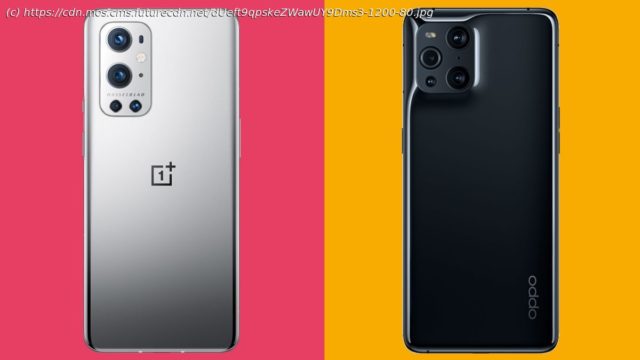OnePlus and Oppo pitch their professional cousins into an almighty smartphone scrap.
The OnePlus 9 Pro and the Oppo Find X3 Pro are a fascinating pair of phones to compare. They’re two of the hottest flagship phones of early 2021, with cutting-edge specs and stand-out camera systems. They also launched within weeks of one another. Besides that, there’s an unmistakable genetic link between the two, with both brands owned by BBK Electronics and frequently sharing components. This one’s a family matter. The OnePlus 9 Pro was released on March 30, 2021 with prices starting from $969 / £829 (around AU$1,250) for 8GB of RAM / 128GB of storage. Bumping things up to 12GB/256GB will cost you $1069 / £929 (roughly AU$1,400). Oppo got in just a few days earlier with its Find X3 Pro, on March 19. The solitary 12GB of RAM and 256GB of storage model costs a chunky £1,099 / AU$1,699 (approximately $1,500), making it one of the pricier smartphones we’ve seen recently. As you’ll have noticed from those currencies, neither phone is universally available. You can’t buy the OnePlus 9 Pro in Australia, and you can’t buy the Oppo Find X3 Pro in the US. Not through official means, at least. Using the common denominator of UK pricing, we can see that the Oppo Find X3 Pro costs £170 (around $234 / AU$307) more than the equivalent top-spec OnePlus 9 Pro. That’s a major mark-up, and a potentially decisive one. We really like both of these phones, but the awkward truth is that both represent a bit of a let-down in design terms. Not everyone will agree with this — beauty being in the eye of the beholder and all — but our reviewer found the Oppo Find X3 Pro to be a little less attractive than the Oppo Find X2 Pro with its distinctive vegan leather and ceramic finish options. The Oppo Find X3 Pro is a good-looking phone in its own right, though, and is certainly more eye-catching than its OnePlus cousin. This is particularly so with a stand-out camera module design, which is incorporated into the body under a single sweep of blistered glass. By contrast, the OnePlus 9 Pro is a little drab. It sticks to a similar design language to the OnePlus 8 and OnePlus 7 families before it, but with a more generic camera module. Aside from this differing approach to camera module integration, and a slight flattening out of the top and bottom edges of the Oppo, the two phones are remarkably similar. Both use a high-grade combination of Gorilla Glass sandwiching an aluminum frame. And both have subtle dual-curved displays and rounded rear panels. Both feel well built, and have the same IP68 dust and water resistance rating. The OnePlus 9 Pro is heavier at 197g, but only by a paltry 4g. At 163.2 x 73.6 x 8.7mm, the OnePlus is ever so slightly thicker than the Oppo, which comes in at 163.6 x 74 x 8.3mm. But again, the difference is hard to gauge even when holding the two phones side by side. Our review model of the Oppo Find X3 Pro came in a muted matte blue finish, but we’ve also used the Gloss Black model. This ultra-reflective shade is an absolute fingerprint magnet, and so too is the Morning Mist model that seems to be fronting most of the OnePlus 9 Pro coverage. This latter shade does at least do something interesting by ‘fogging up’ the top half of the phone, but both reflective finishes look super-greasy in no time. One significant design win for the OnePlus it its physical alert switch on the right-hand edge. Flicking between silent, loud, and vibrate is an all-too-rare treat on Android. If we were to make an educated guess, we’d posit that the OnePlus 9 Pro and the Oppo Find X3 Pro employ identical displays. Given the link between the two companies outlined in the intro, it’s a fair bet. Especially when you break down the specifications. Both have 6.7-inch AMOLED screens with identical 1440 x 3216 (QHD+) resolutions and a shared peak brightness of 1300 nits. Both can scale up to a 120Hz refresh rate, depending on the use case, thanks to LTPO technology. Interestingly, OnePlus claims to be able to scale its refresh rate down to 1Hz, while Oppo claims to be able to drop to 5Hz.






